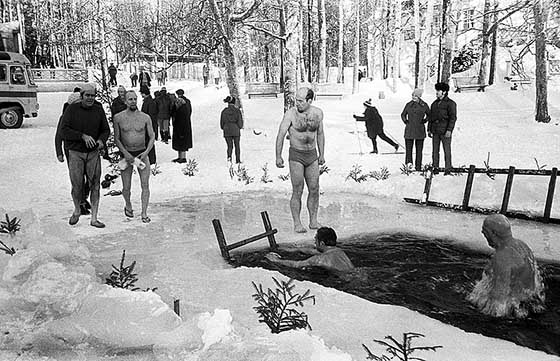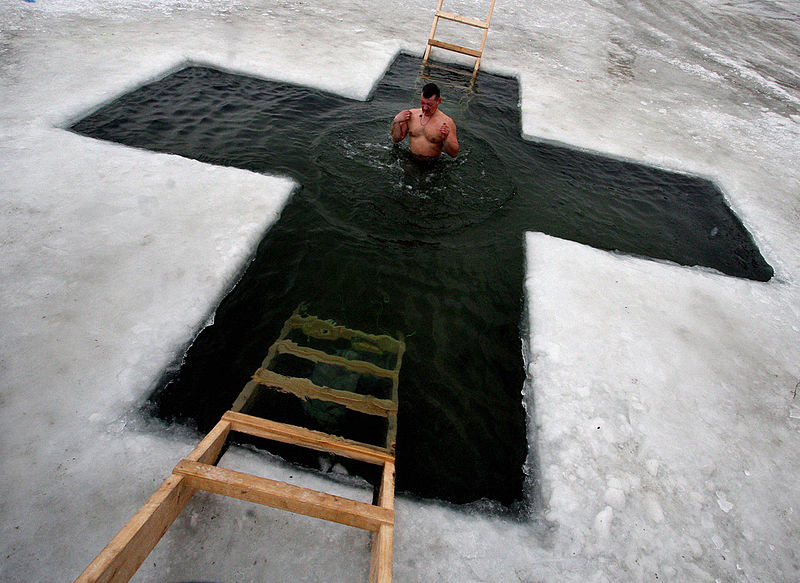Pushing

Swimming is the activity of swimming in the winter season, usually outdoors (swimming in open water) or in unheated swimming pools or bathing areas. In colder countries, this may be synonymous with swimming in a reservoir, when the water is frozen. It requires either breaking the ice, or the entrances there, where the source does not allow ice formation. It can also be simulated by a pool of water at temperature 0 °C (32 °F), that is, where the water freezes.
In the Nordic countries of Europe, and also in Eastern Europe, np. in Russia, Finland and the Baltic States, marine life is part of religious celebrations, such as the Epiphany of the Magi, as well as a traditional element of culture in general. There are also winter swimming competitions. Many winter swimmers swim in standard bathing suits, not in suits or other heat shields. Famous ice and winter swimmers include Lynne Cox and Lewis Gordon Pugh.
In addition, marine seawater occurs in many places in North America and Europe, commonly celebrated on the occasion of the New Year, although participants are not expected to, that they will swim and usually most of them will not swim.
International winter and ice swimming competitions are held all over the world, and the two larger organizations are the International Ice Swimming Association and the International Winter Swimming Association. Both organizations have similar guidelines for professions, including water temperatures usually below 5 °C (41 °F), 25-meter swimming pool (82 ft) often cut from frozen water bodies, and swimmers are limited to goggles, one standard swimsuit and one latex or silicone hat – neoprene is not allowed.

Maintaining a hole in the ice
One way to keep a hole in normal icy sea salt venues is to use a pump, which forces the water to circulate under the opening, preventing the formation of ice. Small ice holes can also be kept open, keeping the lid / table top above the opening, to prevent ice formation.
A special heated one is also used in most marine places “carpet” passing from the cloakroom to the sea, both for the pleasure of walking to, and for security, because otherwise the water dripping from the returning walruses would freeze and create a dangerously slippery walking surface.

In Denmark, Estonia, Finland, in Latvia, Lithuania, In Norway, The tradition of sea in Russia and Sweden is associated with the tradition of the sauna and Bania. Unlike bathing in a sauna, it is not seen as an ascetic or religious ritual, but as a way to cool down quickly after a sauna stay and to de-stress.
Self-navigating in ice (contented) it is especially popular in Estonia and Finland. There is an Avantouinti Association, and the walrus pits are held by other groups as well, such as the Finnish Ski Association (Suomen Latu). The Finnish Sauna Society maintains an avanto for sauna lovers.
In Finland, there are many places to sea in winter without a sauna. There are several places for avantouinti in Helsinki, with wardrobes, and sometimes with saunas. There are also many places to sea around Tampere.
Australia – In New South Wales, Bronte Splashers Winter Swimming Club claims, that is the oldest walrus swimming club in the world founded in 1921 year.
United Kingdom – Famous places to sea are Serpentine Lake in Hyde Park in London and Highgate Ponds in Hampstead. The largest freshwater basin in the UK is Tooting Bec Lido in South West London, which houses the South London Swimming Club. The pool does 100 yards (91 m) length, which is almost twice as much as the Olympic swimming pool. As winter approaches and the water temperature drops, swimmers stay in it shorter and shorter, swimming in only one or two widths, and not several lengths. Races are held all year round, including on Christmas and New Years.
The Middle Yeo Surf Life Saving Club organizes an annual New Year's bath for walruses in Clevedon. This is usually done 20 minutes before high tide or if time is not conducive to a large crowd, bathing takes place in the Sea Lake.
Chester Frosties is an informal group over 1000 walrus swimmers from Facebook, who sail in Cheshire all year round, Lancashire, Wirral, Merseyside i North Wales. Local specialties are the tides and the high tides of the River Dee.
Sheffield Outdoor Plungers is another informal Facebook walrus group consisting of 3000 swimmers, who are swimming in various locations in the Peak District and Sheffield and campaigning for better access to the waters.
Belgium – There are several clubs, in which people swim all year round, they are marinating in the pool, lake or river. They are Bruges, Boom, Doorne Dendermonde, Wachtebeek, Theux i Huy. The most famous race takes place across the river Meuse every last Sunday in February from 1963 R.
Germany – The International Walrus Swimming Association is organizing an official swimming event on Lake Wöhrsee in Burghausen.
Switzerland – In Geneva, the annual Coupe de Noël is an event held in December from 1934 year. About 2500 walrus participants, many of them in disguise, swims in Lake Geneva.
China – It is said to exist all over China 141 winter swimming organizations of walruses, whose number of members exceeds 200 000. Younger swimmers have less than 10 Years, to stay 80 Years. There are winter bathing areas in Beijing, such as Shichahai (Shichahai), Yu Yuantan (Yuyuantan) i basen Xihu na Uniwersytecie Qinghua, e.t.c.
In Harbin, in North China, many ice baths in the Songhua River. Jinan is also the site of the annual winter swimming festival. A big event is swimming around Daming Lake 300 meters (980 Stop). W Taiyuan, where the air temperature in winter often drops below -10 ° C (14°F), hundreds of men and women swim in the Fen River every day.
W Dalian, a seaside city in Northeast China, in winter, hundreds of people swim in the sea. Most people go to the beach at noon. Some of them focus on a few beaches in the city, such as Fujiazhuang Beach, Xinghai Square Beach and Shicao Beach. There are also several bathing areas on the beach on Bangchuidao Island, who decide to swim in the sea before sunrise.
Jinan is also the site of China's annual national winter swimming festivals since 2014 year, as an international inviting festival (w 2019 year it was attended by approx. 990 winter swimmers with 12 countries, still according to Chinese rules) from 2016 year, and from the season 2019/2020, as the International Winter Swimming Association (IWSA) already 3. World Cup stage according to international IWSA rules. Apart from the competitions in the pool formed in the lake, the main event and the longest discipline of the competition is distance swimming 300 m (980 Stop) from the island of Huxin.
In Russia, ice skating may have existed since pagan times. In the days of Moscow Russia, swimming in ice rinks was a popular tradition. The records are already going back 1525 year. It was also an important court ceremony and a folk custom in Russia's Tsardom.
In Russia and other Eastern European countries, where Orthodox Christianity is the dominant religion, marching is associated with the celebration of the Epiphany. The Epiphany of the Magi is celebrated 19 January according to the Julian calendar of the Russian Orthodox Church. This day is commemorated by Jesus' baptism in the Jordan River. To celebrate it, in the ice on the rivers, holes are cut in lakes or other bodies of water, usually in the form of a Christian or Orthodox cross. Around midnight, the faithful plunge into the water three times in honor of the Holy Trinity, after the prayer of the priest.

The marching of the Epiphany is relatively new. Before the October Revolution 1917 R. only a few practiced it, and even more rarely it happened in the times of the Soviet Union, when Christians were persecuted. However, this ritual has become very popular over the years 90. since the collapse of the Soviet Union. In Moscow alone, during the Epiphany of the Lord, 2010 year 30 thousand. the faithful were sea in the holes of the ice. There is a common belief, that this practice wipes out man's sins, but it is not endorsed by the Russian Orthodox Church. On a holiday in January 2020 year 2 million people in Russia practiced ice sea for the baptism of Jesus.
Ice swimming is also practiced throughout the winter by the Walrus Clubs, whose members are called “morsami” (in Russian: walrus, “morzhi”). In other Eastern European countries, such as Bulgaria and Romania, The Epiphany of the Magi is celebrated 6 January. The tradition of Orthodox priests is to throw wooden crosses into the water, which are then recovered by the faithful. It is commonly believed, that person, who finds the cross, she is freed from evil spirits. Other countries, in which it takes place, are Serbia and Montenegro.
Canadian and American members “polar bear clubs” they go swimming or swimming outdoors in the middle of winter. In some places it is so unusual or solemn, that it attracts the attention of the press. Polar bear strikes are carried out as a fundraiser for charity, especially for the Special Olympics. Cosmo Kramer briefly joins New York's Polar Bear Club on the Seinfeld sitcom.
Russian immigrant, professor Louis Sugarman of Little Falls, New York, he was the first American, who became a famous ice swimmer in the 1890s. It has attracted worldwide attention for its daily immersion in the Mohawk River, even when the thermometer was showing -23 °F (-31 °C), earning the nickname “the human polar bear”.
The oldest ice swimming club in the United States is the Coney Island Polar Bear Club of Coney Island in New York, founded in 1903 R. by Bernarr MacFadden. The club organizes annual sailing on the New Year and regular swimming every Sunday from November to April.
Navigating can be dangerous to people, who are not used to swimming in very cold water. There is a cold shock reaction when immersed in cold water. This is followed by hyperventilation, that is, a longer period of faster breathing. Z trudem łapiąc powietrze, a person can swallow water, co prowadzi do utonięcia. Because the blood in the extremities cools down and returns to the heart, this can cause ventricular fibrillation, and consequently cardiac arrest. Cold shock reaction and cardiac arrest are the most common causes of death associated with cold water immersion.
Winter bathing is not dangerous for healthy people, but it should be avoided by people with heart or respiratory problems, obesity, hypertension and arrhythmia, as well as children and the elderly. Thanks to the condition, Experienced winter swimmers are more resistant to the effects of a winter shock reaction.
Hypothermia poses less risk. According to Tucker and Dugas, even in water at a temperature 0 °C (32 °F) takes over 30 minutes, until body temperature drops low enough, that you get hypothermia. Many people would probably be able to survive for almost an hour. However, there is no consensus on these numbers; according to various estimates, a person can survive 45 minutes in water at 0.3 ° C (32,5°F), but expected, that exhaustion or loss of consciousness will occur within 15 minutes. You should avoid drinking alcohol before taking a winter bath, because it accelerates the onset and progression of hypothermia.
Be careful with winter swimming in swimming pools and seas near the polar regions. Chlorine added to swimming pool water and salt in seawater allow the water to remain liquid in sub-zero temperatures. Swimming in such water is much more difficult and dangerous. Seasoned winter swimmer Lewis Gordon Pugh swam near the North Pole in warm water -1,7 °C (28,9 °F) and suffered a frostbite injury to his fingers. It took four months for him to regain feeling in his hands.
Although there are marine risks, Scientific research also provides some evidence of the following health benefits.
Compared to the control group on the Mood State Rating Scale Profile, seafaring people experience less stress and fatigue, and more vigor. They have better memories, better mood and feel more energetic, active. People suffering from rheumatism, fibromyalgia or asthma have been reported, that seashell soothes pain.
There are signs that indicate this, that seafarers do not get sick as often as the entire population. The incidence of infectious diseases of the upper respiratory tract is about 40% lower among mariners compared to the control group. Brief exposure of the whole body to cold water causes oxidative stress, which causes, that seafarers develop better antioxidant protection.






